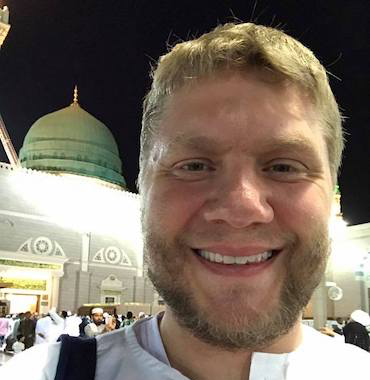
Finding Truth in the Age of Fake News: Information Literacy in Islam
For more on this topic, see The Straight Path - Finding Guidance in an Age of Confusion
Abstract
Introduction
What is Information Literacy?
Knowledge is to recognize what is known, that is, the conception of something one knows, as it exists in reality... Ignorance is to imagine something, that is, to conceive of it, differently than it is in reality.[6]
Misinformation on the internet is dangerous and part of a much larger picture. Bending the truth or telling outright lies is not new. It’s just the messenger who has changed, and this messenger spreads the word lightning fast and to far-flung places. In just the past decade, we have witnessed government leaders and chief executives of major corporations misinform the public in ways that have had enormous consequences, some involving life and death, and others contributing to financial ruin.[8]
Lifelong Learning
Information Authority
Ask yourself: Who wrote this article? Who sponsors the site? Is there an agenda to the content? Is it complete, accurate, and current? What kind of page is it? Is the URL appropriate for the kind of content on the site?
The internet is a powerful tool with a tremendous amount of information to offer, but verify, verify, verify is still the name of the game. When you take all that you’ve investigated into consideration, count on your instincts to tell you whether you can trust the information you’ve found. Don’t take shortcuts, and remember: Buyer beware— even if it isn’t money that’s changing hands.[36]
Roots and Branches
Conclusion
Notes
[1] Oxford Living Dictionaries, “post-truth.” https://en.oxforddictionaries.com/definition/post-truth
[2] Ibn al-Ḥajjāj al-Qushayrī Muslim, Ṣaḥīḥ Muslim ([Bayrūt]: Dār Iḥyāʼ al-Kutub al-ʻArabīyah, 1955), 1:14, al-muqaddimah, bab fi an al-isnad min al-din.
[3] American Library Association (ALA), “Framework for Information Literacy for Higher Education.” http://www.ala.org/acrl/standards/ilframework
[4] Alan Bundy, Information Literacy: The Key Competency for the 21st Century (Adelaide: University of South Australia Library, 1998), 1.
[5] John Naisbitt, Megatrends: Ten New Directions Transforming Our Lives (New York: Warner 1982), 24.
[6] Imām al-Ḥaramayn al-Juwaynī and Jalāl al-Dīn Muḥammad ibn Aḥmad al-Maḥallī, Sharḥ al-Waraqāt fī Uṣūl al-Fiqh (Filasṭīn: Jāmi’at al-Quds, 1999), 79-80.
[7] Sūrat al-Zumar 39:9; M. A. Abdel Haleem, The Qur’an: English translation and parallel Arabic text (Oxford: Oxford University Press, 2010), 460.
[8] Anne P. Mintz, Amber Benham, et al., Web of Deceit: Misinformation and Manipulation in the Age of Social Media (Chicago: Information Today, Inc, 2012), ix-x.
[9] Alan Bundy. Information Literacy: The Key Competency for the 21st Century (Adelaide: University of South Australia Library, 1998), 17.
[10] Sūrat Ṭāhā 20:114; Abdel Haleem, The Qur’an, 321.
[11] Muḥammad ibn Yazīd ibn Mājah, Sunan Ibn Mājah (Bayrūt: Dār Iḥyā’ al-Turāth al-’Arabī, 1975), 1:81 #224, kitab al-muqaddimah, bab fadl al-’ulama’; declared authentic (ṣaḥīḥ) by Al-Albānī in the commentary.
[12] Ismāʻīl ibn ʻUmar ibn Kathīr, Tafsīr al-Qurān al-‘Aẓīm (Bayrūt: Dār al-Kutub al-ʻIlmīyah, 1998), 5:281, verse 10:114.
[13] Sulaymān ibn Aḥmad al-Ṭabarānī, al-Mu’jam al-Kabīr. (al-Qāhirah, al-Riyāḍ: Maktabat Ibn Taymīyah, Dār al-Ṣumayʻī, 1983), 10:180 #10388; declared authentic (ṣaḥīḥ) by Al-Albānī in Ṣaḥīh al-Jāmi’ al-Ṣaghīr ([Dimashq]: al-Maktab al-Islāmī, 1969), 2:1125 #6624.
[14] Muḥammad ibn Ḥibbān, Ṣaḥīḥ Ibn Ḥibbān (Bayrūt: Mu’assasat al-Risālah, 1993), 14:100 #6217, kitab al-tarikh, bab dhikr al-su’al kalim Allah jall wa ‘ala; declared fair (ḥasan) by al-Albānī in the commentary.
[15] Yūsuf ibn ’Abd Allāh ibn ’Abd al-Barr, Jāmi’ Bayān al-’Ilm wa Faḍlih (al-Dammām: Dār Ibn al-Jawzī, 1994), 1:401 #579.
[16] Ibid., 1:406, #586.
[17] Aḥmad ibn Marwān al-Dīnawarī. al-Mujālasah wa Jawāhir wal-’Ilm (al-Baḥrayn: Jam’īyat al-Tarbiyah al-Islāmīyah, 1998), 2:186, #308.
[18] Ibn ’Abd al-Barr, Jāmi’ Bayān al-’Ilm wa Faḍlih, 1:408, #591.
[19] Muslim, Ṣaḥīḥ Muslim, 4:1836 #2363, kitab al-fada’il, bab wujub imtithal ma qalahu shar’an dun ma dhakarahu.
[20] Ibid., 4:1835 #2362.
[21] Ibn Abī Ḥātim, Ādāb al-Shāfi’ī wa Manāqibuh (Bayrūt: Dār al-Kutub al-ʻIlmīyah, 2002) 1:244.
[22] Ibn Mājah, Sunan Ibn Mājah, 2:1263 #3843, kitab al-dua’, bab ma ta’awudh minhu; declared fair (ḥasan) by al-Albānī in the commentary.
[23] Abū Ḥāmid al-Ghazzālī, Iḥyā’ ’Ulūm al-Dīn (Bayrūt: Dār al-Maʻrifah, 1980), 1:30.
[24] Ibn Ḥajar al-Haytamī. al-Fatāwá al-Kubrá al-Fiqhīyah (Bayrūt: Dār al-Kutub al-ʻIlmīyah, 1997), 4:313.
[25] Abd al-Raḥmān ibn Aḥmad ibn Rajab, Jāmi’ al-‘Ulūm wal-Ḥikam (Bayrūt: Mu’assasat al-Risālah, 2001), 1:307, #13.
[26] Sūrat al-Anbiyā’ 21:7; Abdel Haleem, The Qur’an, 323.
[27] Al-Ṭabarī, Jāmiʻ al-Bayān ‘an Ta’wīl al-Qur’ān (Bayrūt: Mu’assasat al-Risālah, 2000), 18:413-414, verse 21:7.
[28] Abū Dāwūd Sulaymān ibn al-Ashʻath al-Sijistānī, Sunan Abī Dāwūd (Ṣaydā, Lubnān: al-Maktabah al-Aṣrīyah, 1980), 1:93, #337, kitab al-taharah, bab fi al-majruh al-tayammum; declared fair (ḥasan) by al-Albānī in the commentary.
[29] Sūrat al-Ḥujurāt 49:6; Abdel Haleem, The Qur’an, 517.
[30] Aḥmad ibn al-Ḥusayn al-Bayhaqī, al-Sunan al-Kubrá (Bayrūt: Dār al-Kutub al-ʻIlmīyah, 2003), 10:178 #20270, kitab adab al-qadi, bab al-tathabut fi al-hukm; declared authentic (ṣaḥīḥ) by Al-Haythamī in Majma’ al-Zawā’id wa Manba’ al-Fawā’id (al-Qāhirah: Maktabat al-Qudsī, 1933), 8:19 #12652.
[31] Muḥammad ibn Aḥmad al-Qurṭubī, Jāmiʻ li-Aḥkām al-Qurʼan (al-Qāhirah: Dār al-Kutūb al-Miṣrīyah, 1964), 16:311-312, verse 49:6.
[32] al-Ṭabarī, Jāmiʻ al-Bayān ‘an Ta’wīl al-Qur’ān, 22:286, verse 49:6.
[33] Ibn Kathīr, Tafsīr al-Qurān al-‘Aẓīm, 7:345, verse. 49:6.
[34] Ron Shaham, The Expert Witness in Islamic Courts: Medicine and Crafts in the Service of Law (Chicago: University of Chicago Press, 2010), 37.
[35] Muslim, Ṣaḥīḥ Muslim, 1:11, #5, al-muqaddimah, bab al-nahi ‘an al-hadith bi-kuli ma samia’.
[36] Anne P. Mintz, Amber Benham, et al., Web of Deceit, 161.
[37] al-Juwaynī and al-Maḥallī, Sharḥ al-Waraqāt fī Uṣūl al-Fiqh, 66.
[38] Maryam Muḥammad Ṣāliḥ al-Ẓufayrī, Muṣṭalaḥāt al-Madhāhib al-Fiqhīyah wa Asrār al-Fiqh al-Marmūz fī al-Aʻlām wal-Kutub wal-Ārāʼ wal-Tarjiḥāt (Bayrūt: Dār Ibn Ḥazm, 2002), 1:92.
[39] Alexandre Koyré, "An Unpublished Letter of Robert Hooke to Isaac Newton." Isis 43, no. 4 (1952): 315. http://www.jstor.org/stable/227384
